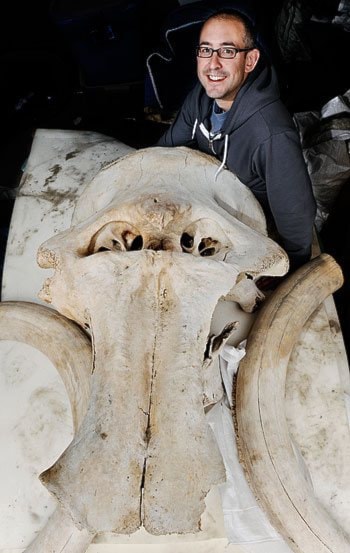Flynn the Mammoth spent at least 30,000 years underground before miners in Dawson City unearthed his skull last week.
A backhoe driver on a minesite near Dawson noticed a tusk protruding from the dirt and began digging carefully around it last Wednesday. He noticed another tusk popping out, and soon a whole skull was discovered.
“We find bones all the time, but I’ve never seen a whole skull intact,” said Grant Zazula, the Yukon’s only paleontologist.
“I don’t think a find like this has been found for 100 years.”
Zazula and other heritage specialists zoomed up to Dawson the next day. They hauled the 115-kilogram skull onto a pallet and it’s now under examination in Whitehorse.
“Something like this has such interpretative and public display value,” said Zazula. “A kid looking at this would be pretty excited and awe-inspired.”
Flynn has to be examined for any cracks that could be repaired with glue, he said. The paleontology office will also send samples to a lab in California for some carbon dating.
The skull, which is about 1.5 meters long and nearly two meters high, was found under 30,000-year-old volcanic ash.
“It’s amazing something like this was preserved,” said Zazula.
The skull doesn’t have any skin or flesh on it, but because there are only a handful of intact mammoth skulls in the world, its measurements will go a long way in understanding the extinct beasts.
“To me, the most important value of this is not scientifically, it’s more about public education because it’s so impressive looking,” he said.
Once all the research is done, the skull will be mounted for pubic viewing.
“Maybe at the Beringia Centre or maybe we’ll bring it back to Dawson,” he said.
The only recorded evidence of a mammoth skull found in the Yukon is an archival photograph of three miners sitting beside one in 1901. That skull was featured in the Chicago World’s Fair, but was soon lost or destroyed.
“Since then, nothing of this quality or stature has ever been found,” he said. “This is probably the best one ever (for Yukon and Alaska).”
Scientists have made breakthroughs recently in understanding mammoth DNA, he said. A recent study demystified how mammoths handled cold weather by looking at genetic information on the animal’s hemoglobin.
Researchers are getting closer to cloning a mammoth, said Zazula.
“It’s not a matter of if, but a matter of when,” he said.
Zazula, who gathers mammoths and fossils from miners on a co-operative basis, will head back to Dawson in the next few weeks. A few rib bones and a shoulder blade were also found at the site.
“So there might be more that they’ll tell us about,” he said.
In the meantime, he wants to name the mammoth skull after the mine site’s manager, John Flynn, who made the decision to donate the skull.
The paleontology office has no estimate on the amount of valuable mammoth ivory that is sold on the black market. And since Zazula is a one-man enforcement team, the office depends on the goodwill of miners to turn in extraordinary finds.
“For them to go out of their way to make sure it gets preserved and to donate it to the government’s paleontology program, he definitely set the example for how miners should work with us in preserving fossils and mammoths,” said Zazula.
Contact James Munson at
jamesm@yukon-news.com
